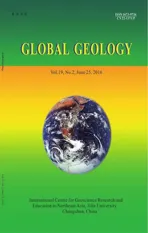Petrogenesis of Paleoproterozoic diorite porphyries in Luojiazhuang, western Shandong: constraints from LA-ICP-MS zircon U-Pb geochronology and geochemistry
2016-07-16YANGHaotianSHIJiangpengHUOTengfeiandYANGDonghong
YANG Haotian, SHI Jiangpeng, HUO Tengfeiand YANG Donghong
1.CollegeofEarthSciences,JilinUniversity,Changchun130061,China;2.ResearchCenterofPalaeontology&Stratigraphy,JilinUniversity,Changchun130026,China
Petrogenesis of Paleoproterozoic diorite porphyries in Luojiazhuang, western Shandong: constraints from LA-ICP-MS zircon U-Pb geochronology and geochemistry
YANG Haotian1, SHI Jiangpeng1, HUO Tengfei1and YANG Donghong2*
1.CollegeofEarthSciences,JilinUniversity,Changchun130061,China;2.ResearchCenterofPalaeontology&Stratigraphy,JilinUniversity,Changchun130026,China
Abstract:Based on the study of LA-ICP-MS zircon U-Pb geochronology and whole-rock geochemistry for the Luojiazhuang diorite porphyries in Menying, western Shandong, the analyzed zircons exhibit oscillatory growth zoning in the cathodoluminescence images and have high Th/U ratios (0.15--1.53), indicating a magmatic origin. In addition, most of the zircons have narrow metamorphic edges, suggesting that late metamorphic events may exist. The youngest group of magmatic zircon207Pb/206Pb ages ranging from 2 384 Ma to 2 234 Ma, yiel-ding a weighted mean age of 2 353±14 Ma, which represents the forming age of the diorite porphyries, as the Early Paleoproterozoic. Geochemically, the samples are characterized by low SiO2(54.54% and 55.47%), high MgO (5.22% and 5.49%) and Mg#values (58 and 59). Moreover, they show enrichment of light rare earth elements and large ion lithophile elements (Rb, Ba and K), depletion of heavy rare earth elements and high field strength elements (Nb, Ta, Zr and Hf), positive anomaly of Pb, and negative anomaly of Ti. The fact implies that the Luojiazhuang diorite porphyries might derive from partial melting of enriched lithospheric mantle and mixed with an amount of continental crust material. In summary, they may form in the compression tectonic setting that stretching along the east-west direction at the North China Craton in the Early Paleoproterozoic.
Key words:Paleoproterozoic; diorite porphyry; geochronology; geochemistry; western Shandong
1Introduction
The North China Craton (NCC) is one of the oldest Archean cratons, its formation and evolution have been one of the hottest issues (Zhaoetal., 2001, 2005; Rogers & Santosh, 2003; Zhaietal., 2005; Wanetal., 2015). In the western Shandong of the eastern NCC, a large number of Precambrian crystal basement is developed, which looks a natural laboratory for the study of the Precambrian evolution (Wanetal., 2011, 2014a, 2014b). Based on a large number of research results, Wanetal. (2015) suggested the western Shandong area developed severe magma activities in ~2.6 Ga and then had studied with focus on the evolution of the western Shandong Precambrian basement in the Early Neoarchean (2.75--2.6 Ga) and the Late Neoarchean (2.6--2.5 Ga). They considered that the western Shandong is the only area where the Early and Late Neoarchean basement rock series coexist in the NCC. However, the study on the Early Paleoproterozoic magmatic activity in the wes-tern Shandong is relatively scarce. Thus, this paper reports LA-ICP-MS zircon U-Pb dating results and geo-chemical data of the Luojiazhuang diorite porphyries in order to discuss their formation ages and petrogeneses, which would a important role in exploring the tectonic evolution of the western Shandong in the Early Paleoproterozoic.
2Geological background
The NCC is surrounded by the Qinling-Dabie Orogenic, the Sulu Orogenic and the Xingmeng Orogenic belts (Fig.1). Based on the dating research of the ancient metamorphic rocks, rock assemblages, tectonic evolution andp-T-tpath, the NCC is divided into the eastern and western blocks, and the Central Orogenic belt (Zhaoetal., 2001, 2005). The wes-tern Shandong is located in the eastern block of the NCC (Fig.1a). It consists of the Archean Taishan Group, the Cambrian, Lower-Middle Ordovician Series and the Carboniferous-Permian sequences. The Mesozoic strata are mainly composed of the faulted basin sedimentary rocks, whereas the Cenozoic strata consist of the river-lake sedimentary rocks (BGMRSP, 2003). The Precambrian and Mesozoic igneous rocks are widespread throughout the western Shandong (Yangetal., 2012).
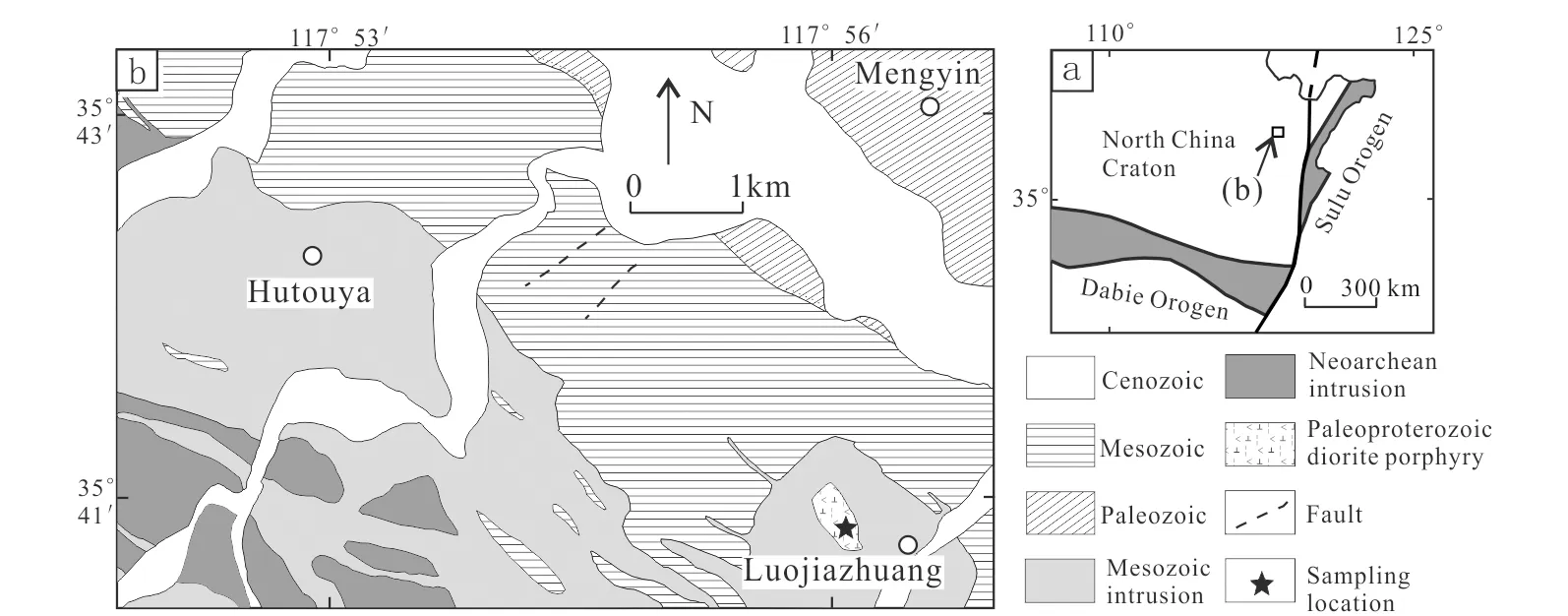
(a) Tectonic sketch of NCC; (b) geological map and the locations of the samples.Fig.1 Geological map for Luojiazhuang diorite porphyries
The diorite porphyries are exposed in about 1 km northwest of Luojiazhuang village in Mengyin County (Fig.1a), and share a total outcrop of about 0.5 km2. The Early Cretaceous Hutouya granodiorite porphyries can be found within the intrusion (Xuetal., 2004). The samples present prophyritic texture and massive structure and mainly consist of diorite porphyries (Fig.2a). The phenocrysts mostly comprise hornblende (accounted for 40% of phenocrysts) and plagioclase (accounted for 60%). The matrix consists of predominantly plagioclase, hornblende and minor biotite (Fig.2b).

(a) Field photo; (b) micrographs of Luojiazhuang diorite porphyries.Fig.2 Photos of petrography
3Geochronology
We collected samples of 10 kg in the field, and
then separated the zircons by standard density and magnetic techniques. The zircons were bonded to the double face adhesive, fitted with sample target ring and mounted in epoxy. The zircons were dried and polished until the interior structures of those grains exposed. Zircon LA-ICP-MS U-Pb dating and catho-doluminescence (CL) images were conducted at the National Key Laboratory of Geological Processes and Mineral Resources, China University of Geosciences (Wuhan). We use international standard zircon 91500 as external standard for correcting isotope fractionation. The detailed experiment method can be found in Liu Y Setal. (2010).
Fig.3 shows that the zircons from Luojiazhuang diorite porphyries have core-rim structure. The cores show rhythmic growth zoning, indicating that they are magmatic origin, which are consistent with their relatively high Th/U ratios (0.15--1.53). The edges of zircons display uniform narrow structure side, indicating they are metamorphic origin. The youngest group of magmatic zircon207Pb/206Pb ages ranges from 2 384 Ma to 2 234 Ma, yielding a weighted mean age of 2 353±14 Ma (MSWD=1, n=14), which suggests that the formation crystallization age of the diorite porphyries is 2 353±14 Ma. Captured zircon ages of magma origin of two other groups range from 2 472--2 402 Ma to 2 526--2 499 Ma, respectively (Fig.3) (Table 1). They yield weighted mean age of 2 434±23 Ma (MSWD=5, n=8) and 2 509±170 Ma (MSWD=2, n=2), respectively. The metamorphic edges of zircons are narrow, which we have not studied.
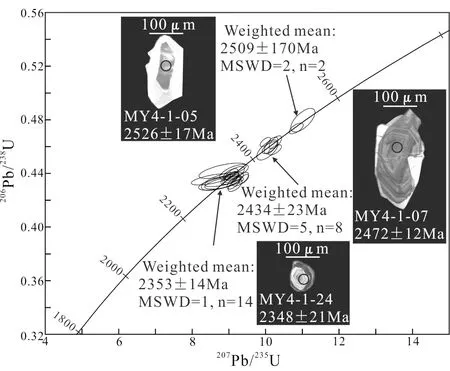
Fig.3 U-Pb concordia diagram and CL image of representative zircons for Luojiazhuang diorite porphyries
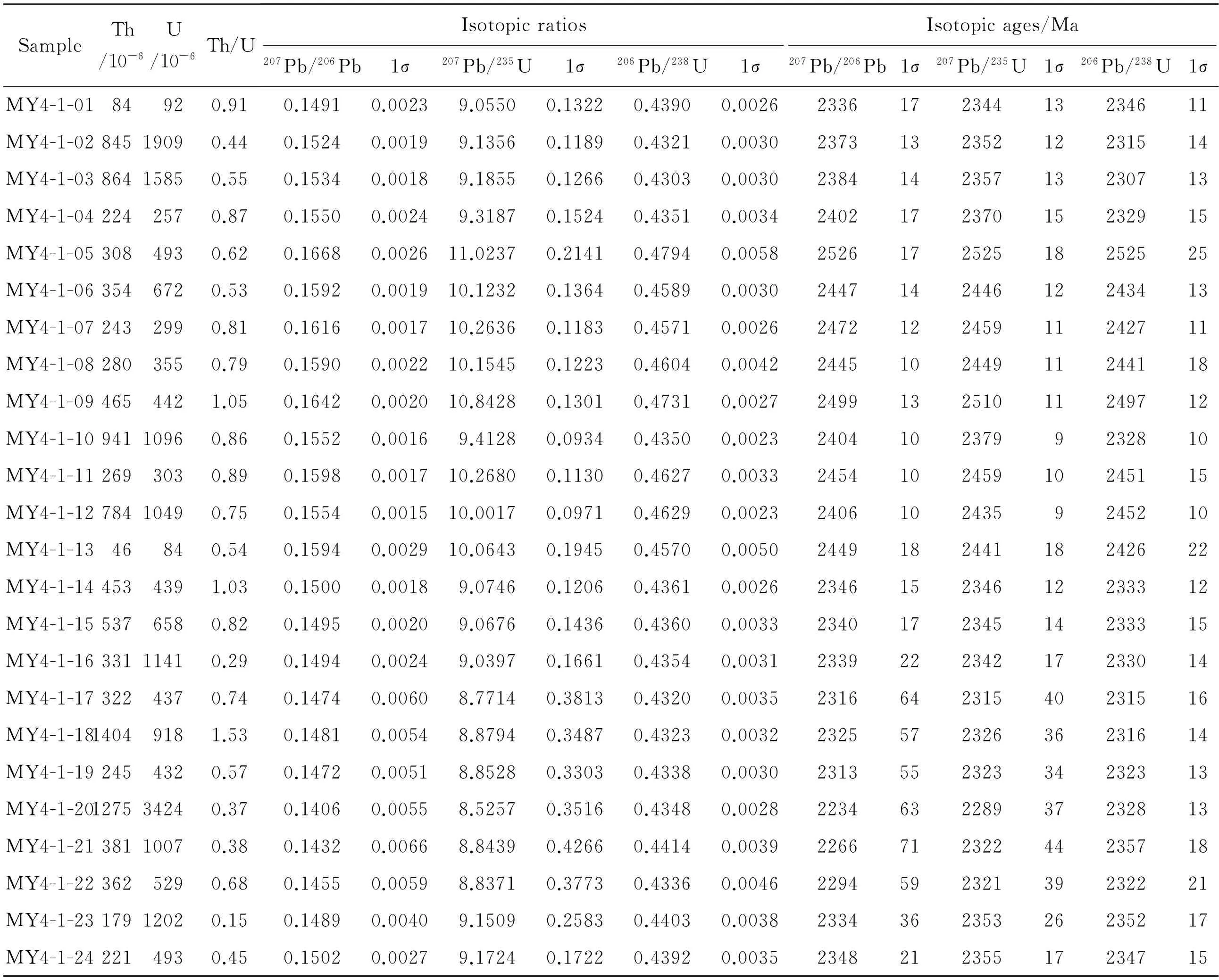
SampleTh/10-6U/10-6Th/UIsotopicratiosIsotopicages/Ma207Pb/206Pb1σ207Pb/235U1σ206Pb/238U1σ207Pb/206Pb1σ207Pb/235U1σ206Pb/238U1σMY4-1-0184920.910.14910.00239.05500.13220.43900.0026233617234413234611MY4-1-0284519090.440.15240.00199.13560.11890.43210.0030237313235212231514MY4-1-0386415850.550.15340.00189.18550.12660.43030.0030238414235713230713MY4-1-042242570.870.15500.00249.31870.15240.43510.0034240217237015232915MY4-1-053084930.620.16680.002611.02370.21410.47940.0058252617252518252525MY4-1-063546720.530.15920.001910.12320.13640.45890.0030244714244612243413MY4-1-072432990.810.16160.001710.26360.11830.45710.0026247212245911242711MY4-1-082803550.790.15900.002210.15450.12230.46040.0042244510244911244118MY4-1-094654421.050.16420.002010.84280.13010.47310.0027249913251011249712MY4-1-1094110960.860.15520.00169.41280.09340.43500.002324041023799232810MY4-1-112693030.890.15980.001710.26800.11300.46270.0033245410245910245115MY4-1-1278410490.750.15540.001510.00170.09710.46290.002324061024359245210MY4-1-1346840.540.15940.002910.06430.19450.45700.0050244918244118242622MY4-1-144534391.030.15000.00189.07460.12060.43610.0026234615234612233312MY4-1-155376580.820.14950.00209.06760.14360.43600.0033234017234514233315MY4-1-1633111410.290.14940.00249.03970.16610.43540.0031233922234217233014MY4-1-173224370.740.14740.00608.77140.38130.43200.0035231664231540231516MY4-1-1814049181.530.14810.00548.87940.34870.43230.0032232557232636231614MY4-1-192454320.570.14720.00518.85280.33030.43380.0030231355232334232313MY4-1-20127534240.370.14060.00558.52570.35160.43480.0028223463228937232813MY4-1-2138110070.380.14320.00668.84390.42660.44140.0039226671232244235718MY4-1-223625290.680.14550.00598.83710.37730.43360.0046229459232139232221MY4-1-2317912020.150.14890.00409.15090.25830.44030.0038233436235326235217MY4-1-242214930.450.15020.00279.17240.17220.43920.0035234821235517234715
4Petrogeochemistry
4.1Major elements
Whole-rock major and trace elements were con-
ducted at the National Key Laboratory of Geological Processes and Mineral Resources, China University of Geosciences (Wuhan). Major and trace elements were determined by X-ray fluorescence (XRF) spectrometer and Agilent 7 500 a inductively couple plasma mass spectrometry (ICP-MS), respectively. The analytical precision is better than 5% and 10%, respectively. The Luojiazhuang diorite porphyries have SiO2=54.54%, 55.47%, TiO2=0.81%, 0.85%, Al2O3=15.69%, 15.73%, MgO = 5.22%, 5.49%, CaO=6.56%, 6.63%, Na2O=3.71%, 3.83%, K2O=1.85%, 1.93%, Mg#=58, 59 and Na2O/K2O=1.98, 2.00 (Table 2). They are characterized by low contents of SiO2, high amounts of MgO and Mg#. The solid line represents the boun-dary between sub-alkaline and the alkaline serieses in Fig.4a in which the samples belong to sub-alkaline series, i.e. monzodiorite. In Fig.4b, they belong to the scope of High-K calc-alkaline series.
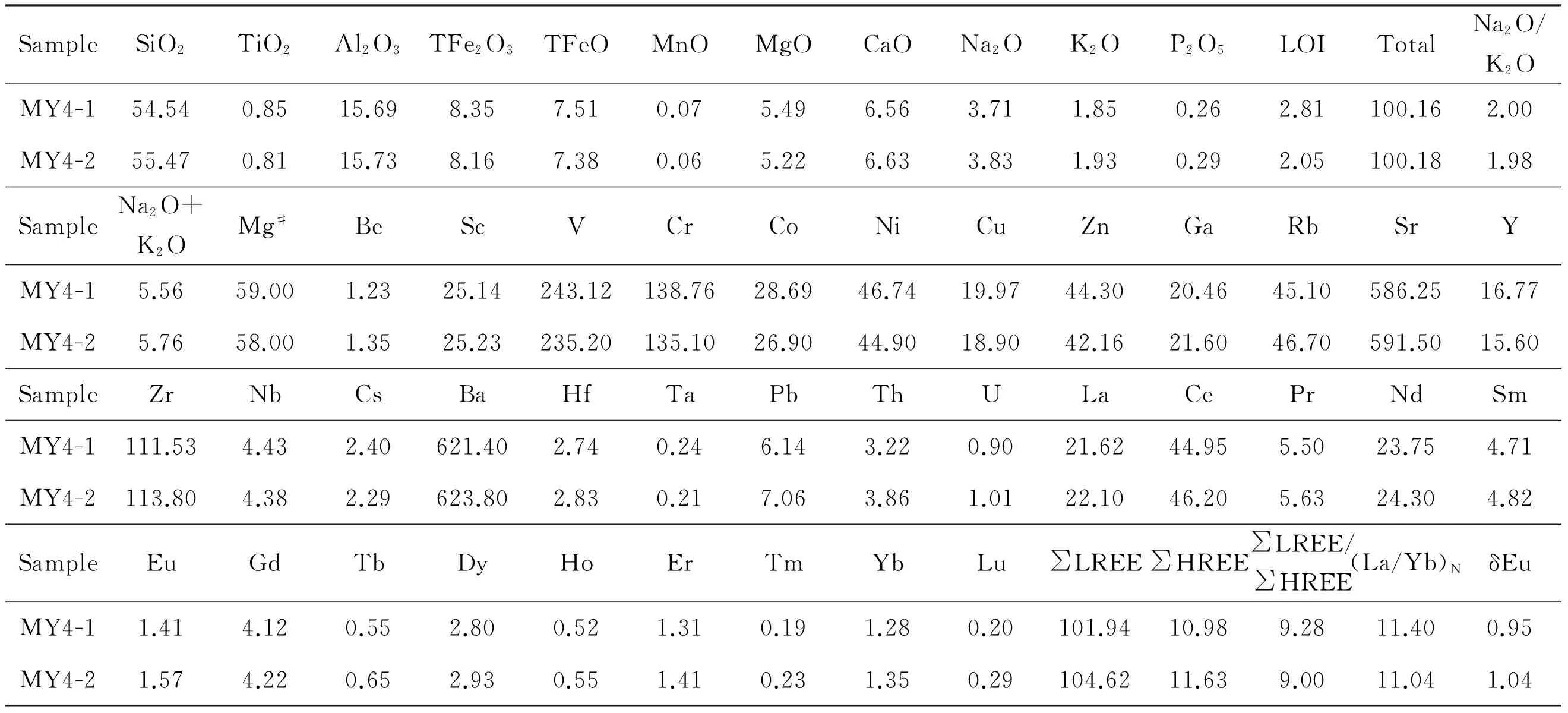
Table 2 Major (wt.%) and trace elements (10-6) data for Luojiazhuang diorite porphyries
4.2Trace elements
The Luojiazhuang diorite porphyries are characterized by enrichment of light rare earth elements (LREEs) and depletion of heavy rare earth elements (HREEs) (Fig.5a). The fractionations of LREEs and HREEs are distinct. For instance, the samples have high ∑LREE/∑HREE ratios (9.00, 9.28), (La/Yb)N= 11.04 and 11.40, and δEu=0.95 and 1.04. They have similar REEs abundance as the ~2.48 Ga Dongxigao diorite porphyries in the wes-tern Shandong. It can be seen from the Fig.5b that the samples show enrichment in large ion lithophile elements (LILEs: Rb, Ba and K), and depletion in high field strength elements (HFSEs: Nb, Ta, Zr and Hf) with positive Pb and negative Ti anomalies, which are similar to the ~2.48 Ga Dongxigao diorite porphyries. The contents of Cr, Co and Ni in the Luojiazhuang diorite porphyries are 135×10-6and 139×10-6, 26.9×10-6and 28.7×10-6, 44.9×10-6and 46.7×10-6, respectively.

(a) TAS classification diagram; (b) K2O versus SiO2diagram.Fig.4 Petrochemical classifications for Luojiazhuang diorite porphyries
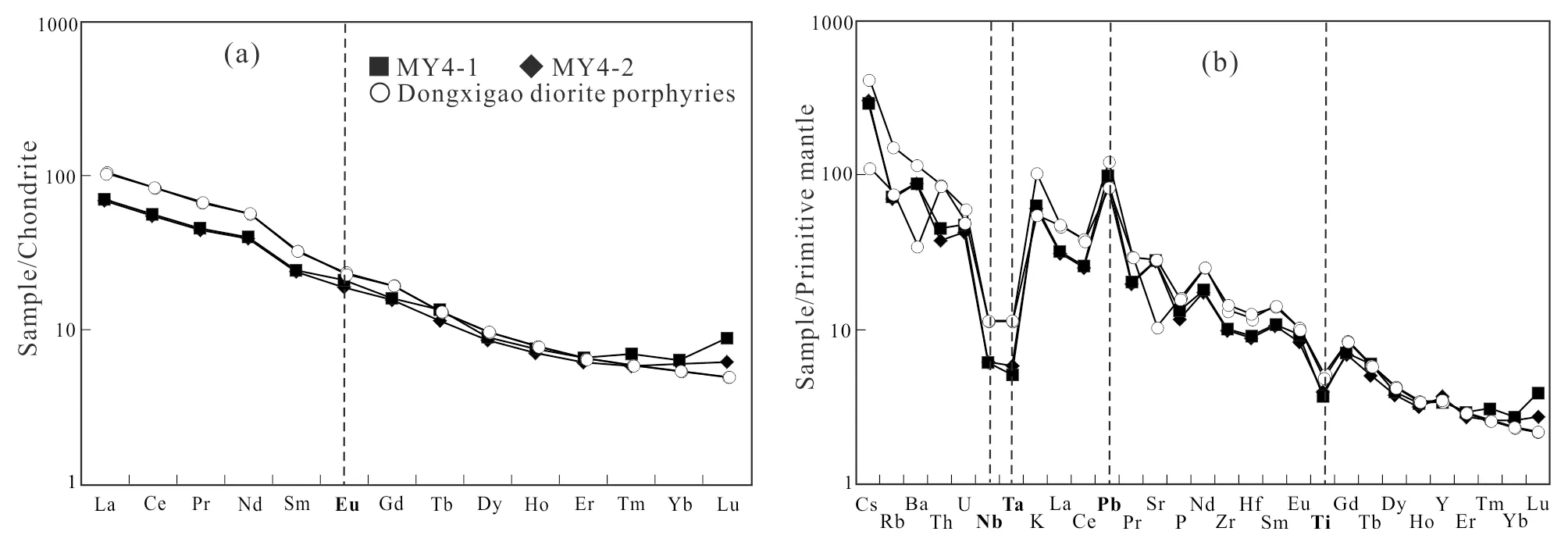
(a) Chondrite-normalized REE patterns; (b) primitive mantle-normalized trace element spider diagram.Fig.5 Trace element diagrams for Luojiazhuang diorite porphyries
5Discussion
5.1Formation age of Luojiazhuang diorite porphyries
In the Luojiazhuang-Hutouya area, south of the Mengyin County in western Shandong, a lot of Hu-touya granodiorite porphyries and Neoarchean-Paleoproterozoic intrusions can be found. The previous research on the zircon U-Pb and biotite40Ar/39Ar dating of the Hutouya granodiorite porphyries showed that they were formed in the Early Cretaceous (133--130 Ma)(Xuetal., 2004; Wangetal., 2016). But, the Neoarchean Paleoproterozoic intrusion intruded by the Hutouya granodiorite porphyries are lack of precise isotopic dating. The youngest group of magmatic zircons from Luojiazhuang diorite porphyries yields a weighted mean207Pb/206Pb age of 2 353±14 Ma, which represents the crystallization age of the diorite porphyries, as the Early Paleoproterozoic. The result is consistent with the inherited zircon ages (2 437--2 421 Ma) of Hutouya granodiorite porphyries in the Early Cretaceous (Wangetal., 2016). Comparing with the LA-ICP-MS zircon U-Pb dating from the Xiaohe granites in the southern NCC (2 328 Ma)(Li, 2011), we find that they have the same results. Therefore, we suggest that magmatic events occurred in the NCC in the Early Paleoproterozoic. Furthermore, the captured magmatic-origin zircons207Pb/206Pb ages of two groups yield 2 434 Ma and 2 509 Ma, respectively. The former is consistent with the both of LA-ICP-MS zircon U-Pb dating results of the Dongxi-gao diorite porphyries (2 478 Ma), and the magmatic zircons SHRIMP U-Pb dating results of the Taishan complex rocks (2 480--2 479 Ma) (Luetal., 2008).
5.2Petrogenesis and tectonic background
The Luojiazhuang diorite porphyries are characterized by low amounts of SiO2, high contents of MgO and Mg#values (58, 59). They show enrichment of Na and transitional elements. The above characteristics show that the studied rocks derived from enriched lithospheric mantle (Rudnick & Gao, 2003), which is also supported by the enriched LREEs and LILEs (Rb, Ba and K) in these samples. In addition, the Luojiazhuang diorite porphyries show obviously depletion in Nb, Ta, Zr and Hf, and enrichment in Pb. Combining with the presence of captured zircons in rocks, we suggest that crustal materials existed in the magma source and are involved in the magmatic evolution. This is consistent with the characteristics of the Dongxigao diorite porphyries which also originate from the enriched lithospheric mantle where it mixed with crustal materials. The Luojiazhuang diorite porphyries are characterized by weak negative Eu anomaly (δEu=0.95, 1.04), which shows that plagioclase is not the main residual phase in the source region or does not produce apparent fractional crystallization. The loss of HREEs abundance implies that garnets may be the important residual phase in the source region. The loss of P and Ti elements in samples may be associa-ted with the fractional crystallization of apatites and ilmenites during the magmatic evolution.
The Neoarchean magmatic activities of the NCC can be divided into the Early Neoarchean (2.75--2.6 Ga) and the Late Neoarchean (2.6--2.5 Ga) (Wanetal., 2015). And the magmatism was relatively weak in 2.5--2.3 Ga (Zhai & Peng, 2007; Li, 2011). Recently, the high precision dating of the basement rocks in the central NCC shows the Paleoproterozoic tectonic evolution of the NCC may begin in 2.4--2.3 Ga (Liu C Hetal., 2010). The studies on magmatic zircons from the Lüliang Mountains area and detrital zircons from the Zhongtiao Mountains area show that Lüliang Group has much information of 2 400--2 100 Ma magmatic zircon. But the Yejishan Group and the Lanhe Group have more information of 2 100--1 800 Ma magmatism events (Gengetal., 2000). Moreover, Baietal. (1993) suggested that the Paleoproterozoic of the NCC may have two extention-compression tectonic evolutions: the early stages of (2 400--2 100 Ma) extention and compression events stretching along nearly E-W; and the late stage of (2 100--1 800 Ma) tension and compression events stretching along nearly S-N. Therefore, the Luojia-zhuang diorite porphyries in western Shandong may be formed in the extension and compression tectonic setting stretching along nearly E-W in the Early Paleoproterozoic in the NCC.
6Conclusions
(1) The youngest group of magmatic zircons yields a weighted mean207Pb/206Pb age of 2 353 Ma, which suggests that the Luojiazhuang diorite porphyries were formed in the Early Paleoproterozoic.
(2) The Luojiazhuang diorite porphyries are characterized by low contents of SiO2, high amounts of MgO, enrichment in Na2O, LREEs and LILES (Rb, Ba and K), depletion in HREEs and HFSEs (Nb, Ta, Zr and Hf), positive anomaly of Pb, and negative anomaly of Ti.
(3) The Luojiazhuang diorite porphyries derived from partial melting of enriched lithospheric mantle and have the involvement of the continental crust material. They may be formed in the extension and compression tectonic setting stretching along nearly E-W in the Early Paleoproterozoic in the NCC.
References
Bai J, Huang X G, Dai F Y,etal. 1993. The Early Precambrian crust evolution of China. Beijing: Geological Publishing House, 1-219. (in Chinese).
Bureau of Geology and Mineral Resources of Shandong Province (BGMRSP). 2003. Regional geology of Shandong Pro-vince. Ji’nan: Shandong Mapping Press. (in Chinese).
Geng Y S, Wan Y S, Shen Q H,etal. 2000. Chronological framework of the Early Precambrain important events in the Lüliang area, Shanxi Province.ActaGeologicaSinica, 74(3): 216-223. (in Chinese with English abstract).
Li C L. 2011. The geochronology and tectonic implications of granite gneiss and Xiaohe granite in Taihua Group of Xiaoqinling area: master’s degree thesis. Biejing: Chinese Academy of Geological Sciences. (in Chinese with English abstract).
Liu C H, Liu S W, Li Q G,etal. 2010. Petrogenesis of the Paleoproterozoic Guandishan granitoids in Shanxi Pro-vince: constraints from geochemistry and Nd isotopes.ActaGeologicaSinica, 80(6): 925-935.
Liu Y S, Gao S, Hu Z C,etal. 2010. Continental and ocea-nic crust recycling-induced melt-peridotite interactions in the Trans-North China Orogen: U-Pb dating, Hf isotopes and trace elements in zircons from mantle xenoliths.Journalofpetrology, 51(1/2): 537-571.
Lu S N, Chen Z H, Xiang Z Q. 2008. Chronological framework of ancient intrusion series in the World Geological Park of the Taishan. Beijing: Geological Publishing House, 1-90. (in Chinese).
Rogers J J W, Santosh M. 2003. Supercontinents in earth history.GondwanaResearch, 6(3): 357-368.
Rudnick R, Gao S. 2003. Composition of the Continental Crust.TraetiseonGeocheemistry, 3:1-64.
Wan Y S, Dong C Y, Wang S J,etal. 2014a. Middle Neoarchean magmatism in western Shandong, North China Craton: SHRIMP zircon dating and LA-ICP-MS Hf isotope analysis.PrecambrianResearch, 255: 865-884.
Wan Y S, Xie S W, Yang C H,etal. 2014b. Early Neoarchean (~2.7 Ga) tectono-thermal events in the North China Craton: a synthesis.PrecambrianResearch, 247: 45-63.
Wan Y S, Liu D Y, Wang S J,etal. 2011. ~2.7 Ga juve-nile crust formation in the North China Craton (Taishan-Xintai area, western Shandong Province): further evidence of an understated event from U-Pb dating and Hf isotopic composition of zircon.PrecambrianResearch, 186(1/4): 169-180.
Wan Y S, Wang S J, Ren P,etal. 2015. Neoarchean magmatism in the Culaishan area, western Shandong: evidence from SHRIMP zircon U-Pb dating.ActaGeoscienticaSinica, 36(5): 634-646. (in Chinese with English abstract).
Wang H, Xu Z W, Lu X C,etal. 2016. Two-types of Early Cretaceous adakitic porphyries from the Luxi terrane, eas-tern North China Block: melting of subducted PaleoPacific slab and delaminated newly underplated lower crust.Lithos, 240-243: 140-154.
Xu W L, Wang D Y, Wang Q H,etal. 2004.40Ar/39Ar da-ting of hornblende and biotite in Mesozoic intrusive complex from the North China Block: constraints on the time of lithospheric thinning.Geochimica, 33(3): 221-231. (in Chinese with English abstract).
Yang D B, Xu W L, Pei F P,etal. 2012. Spatial extent of the influence of the deeply subducted South China Block on the southeastern North China Block: constraints from Sr-Nd-Pb isotopes in Mesozoic mafic igneous rocks.Lithos, 136-139: 246-260.
Zhai M G, Guo J H, Liu W J. 2005. Neoarchean to Paleopro-terozoic continental evolution and techonic history of the North China Craton: a review.JournalofAsianEarthSciences, 24(5): 547-561.
Zhai M G, Peng P. 2007. Paleoproterozoic events in the North China Craton.ActaPetrologicaSinica, 23(11): 2665-2682. (in Chinese with English abstract).
Zhao, G C, Sun M, Wilde S A,etal. 2005. Late Archean to Paleoproterozoic evolution of the North China Craton: key issues revisited.PrecambrianResearch, 136(2): 177-202.
Zhao G C, Wilde S A, Cawood P A,etal. 2001. Archean blocks and their boundaries in the North China Craton: lithological, geochemical, structural andP-Tpath constraints and tectonic evolution.PrecambrianResearch, 107(1/2): 45-73.
doi:10.3969/j.issn.1673-9736.2016.02.03
*Corresponding author(Email: yangdonghong@jlu.edu.cn)
Article ID: 1673-9736(2016)02-0078-07
Received 16 December 2015, accepted 18 February 2016
Supported by the Program for New Century Excellent Talents in University (No.NCET-12-0237), the Natural Science Foundation of China (No.41472052), and Basic Scientific Research Foundation of Central Universities of China.
杂志排行
Global Geology的其它文章
- Geochronology and geochemistry of Dongxigao diorite porphyries: implications for Late Neoarchean tectonic evolution of eastern North China Craton
- Genesis of lower strain S-L-type tectonites in Daqingshan area, Inner Mongolia
- Comparison of finite difference and pseudo-spectral methods in forward modelling based on metal ore model of random media
- Study of formation boundary and dip attribute extraction based on edge detection technology
- Subsurface sandstone mapping by combination of GPR and ERT method
- Rock physics and seismic modeling of shale reservoirs with horizontal fractures
